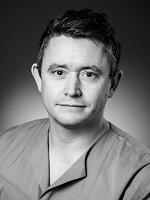The University of Oslo is closed and the public defence will be held as a video conference over Zoom.
The defence will follow regular procedure as far as possible, hence it will be open to the public and the audience can ask ex auditorio questions when invited to do so.
Click here to participate in the public defence The room opens at 27 March, 2020, 9:30 AM.
Digital Trial Lecture - time and place
Adjudication committee
- First opponent: Senior Consultant Stefano Caselli, Cardiovascular Center Zürich, Switzerland
- Second opponent: Assistant Professor Espen Holte, Department of Circulation and Medical Imaging, Norwegian University of Science and Technology, Trondheim
- Third member and chair of the evaluation committee: Associate Professor Kirsten Krohg-Sørensen, Institute of Clinical Medicine, University of Oslo
Chair of defence
Professor Emeritus Odd Geiran, Institute of Clinical Medicine, University of Oslo
Summary
Mitral annulus disjunction is a gap between the mitral ring and the ventricular myocardium and is associated with mitral valve prolapse. Previous life-threatening arrhythmias were prevalent (12%) in the study population of 116 patients with mitral annulus disjunction. Markers of severe ventricular arrhythmias were lower age, subtle left ventricular dysfunction, papillary muscle fibrosis and absence of concomitant mitral valve prolapse. Mitral annulus disjunction should be considered in the clinical evaluation of patients with malignant cardiac arrhythmias.
The hereditary cardiac diseases arrhythmogenic cardiomyopathy and hypertrophic cardiomyopathy are frequent causes of sudden death in the young. High intensity exercise was a strong marker of life-threatening arrhythmias and worse cardiac function in arrhythmogenic cardiomyopathy. Contrarily, in hypertrophic cardiomyopathy, increased exercise was neither associated with ventricular arrhythmias nor increased myocardial hypertrophy and correlated to better diastolic left ventricular function. The results support exercise restriction in arrhythmogenic cardiomyopathy and encourage exercise execution in hypertrophic cardiomyopathy.
Pincipal Supervisor
Associate Professor Kristina H. Haugaa, Institute of Clinical Medicine, University of Oslo
Additional information
contact the Research Support staff
